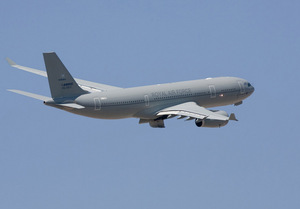Lockheed Martin-Built Trident II D5 Missile Achieves 127 Successful Test Flights
July 31, 2009
Royal Navy Fleet Ballistic Missile Launched in Test in the Atlantic
SUNNYVALE, Calif., July 30 /PRNewswire/ — The U.S. Navy supported the May 26 launch of a U.K. Royal Navy Trident II D5 Fleet Ballistic Missile (FBM) built by Lockheed Martin (NYSE: LMT). The unarmed missile was launched from the submerged Royal Navy submarine HMS Victorious (UK SSBN 06) in the Atlantic Ocean. The Trident II D5 missile now has achieved 127 consecutive successful test flights since 1989 – a record unmatched by any other large ballistic missile or space launch vehicle.
“This performance has been achieved in tests conducted by the U.S. Navy and the Royal Navy over the past two decades,” said Melanie A. Sloane, vice president of Fleet Ballistic Missile programs, Lockheed Martin Space Systems Company, the Trident missile prime contractor. “The cooperation of both governments, supported by industry, provides a credible strategic deterrent.”
The test was part of a Demonstration and Shakedown Operation following an overhaul of the submarine. For the test, a missile was converted into a test configuration using a test missile kit produced by Lockheed Martin that contains range safety devices and flight telemetry instrumentation.
First deployed in 1990, the D5 missile is currently aboard U.S. Navy OHIO-class and Royal Navy VANGUARD-class submarines. The three-stage, solid-propellant, inertial-guided ballistic missile can travel a nominal range of 4,000 nautical miles and carries multiple independently targeted reentry vehicles.
Lockheed Martin Space Systems Company, Sunnyvale, Calif., is the prime contractor and program manager for the Trident missile. Lockheed Martin provides program management and engineering services for the United Kingdom’s Trident II D5 Fleet Ballistic Missile program through an annual contract funded by the U.K. Royal Navy, with work performed at facilities in the United States and the United Kingdom. For the period from April 1, 2009, through March 31, 2010, Lockheed Martin has been awarded a contract of $21.3 million contract for United Kingdom technical services in support of the Trident Missile System.
Lockheed Martin Space Systems has been the U.S. Navy’s prime strategic missile contractor since the inception of the program more than 50 years ago. Since 1968, Lockheed Martin has provided program support to the Royal Navy under the terms of the 1963 U.S.-U.K. Polaris Sales Agreement, which was modified in 1982 to provide for the Trident II D5 ballistic missile system.
U.S. House Affirms Competition for Joint Strike Fighter Propulsion
July 31, 2009
EVENDALE, OHIO – July 30, 2009 – The U.S. House of Representatives is
leading the charge for defense acquisition reform by voting 400 to 30
on Thursday for a defense spending bill for fiscal year 2010 that
includes $560 million in funding for the GE Rolls-Royce Fighter Team’s
F136 engine for the F-35 Joint Strike Fighter (JSF).
By supporting the F136 – the competing JSF engine that is already more
than 70 percent through its development – the House sets the stage for
annual, head-to-head competition to the F-35 propulsion system, and
avoids a decades-long, $100 billion engine monopoly being handed to a
sole-source provider. In the history of the JSF program, there has
never been an engine competition.
The GE Rolls-Royce Fighter Engine Team consistently receives top
reviews from the Joint Program Office for program execution, including
budget performance. The first production F136 engines are scheduled
for delivery in 2012. Over time, the F136 engine program will more
than pay for itself through decades of annual competitions that drive
performance and cost improvements by design.
This year, the F136 engine has garnered support in both steps of the
U.S. House budget process; defense authorization and defense
appropriations.
“For 14 years, the F136 has received consistent, bipartisan support in
Congress because competition is the critical cost-control mechanism
for defense procurement,” said David Joyce, President and CEO of GE
Aviation. “The GE Rolls-Royce Fighter Engine Team simply seeks the
opportunity to compete.”
More than $2.5 billion has been invested in developing the GE
Rolls-Royce F136 engine, including more than $50 million from GE and
Rolls-Royce. The benefits of competition have been verified by
numerous studies and U.S. military experience. The JSF program’s
international partners in the F-35 program also support competing
engines.
Speaking to Congressional Quarterly, House Defense Appropriations
Chairman John P. Murtha this week described the F136 engine program as
“absolutely critical,” adding, “An alternative engine will provide
cost savings through competition as well as provide greater
reliability down the road.”
History has shown that competition in aircraft engine programs
significantly reduces cost, while improving safety, reliability, and
contractor responsiveness. The “Great Engine War,” the 20-year battle
to power the F-16 fighter, demonstrated these exact results with cost
savings of at least 20 percent.
The F136 engine is the most advanced fighter aircraft engine ever
developed and will be available to power all variants of the F-35
Lightning II aircraft for the U.S. military and eight partner nations.
The first complete new-build F136 engine began testing earlier this
year under the System Development and Demonstration (SDD) contract
with the U.S. Government Joint Program Office for the F-35 Joint
Strike Fighter program. The F136 engine is a product of the best
technology from two world-leading propulsion companies. The GE
Rolls-Royce Fighter Engine Team has designed the only engine
specifically developed for the F-35 aircraft, offering extra
temperature margin and affordable growth.
F136 engine development is being led at GE Aviation in Evendale, Ohio
(Cincinnati suburb), Ohio; and at Rolls-Royce in Indianapolis,
Indiana.
The F-35 is a 5th-generation, multi-role aircraft designed to replace
the AV-8B Harrier, A-10, F-16, F/A-18 Hornet and the United Kingdom’s
Harrier GR.7 and Sea Harrier, all of which are currently powered by GE
or Rolls-Royce. Potential F-35 production for the U.S. Air Force,
Navy, Marines and international customers may reach as many as 5000 to
6000 aircraft over the next 30 years.
Raytheon Awarded $30 Million for Space Fence System Design and Prototyping
July 15, 2009
TEWKSBURY, Mass., July 15, 2009 /PRNewswire/ — Raytheon Company (NYSE: RTN) was awarded one of three $30 million contracts for Phase A system design and prototype of the Space Fence system. Space Fence will provide the U.S. Air Force enhanced space surveillance capability to detect and report space objects.
“Space Fence is the future of space situational awareness,” said Pete Franklin, vice president for Raytheon Integrated Defense Systems’ National & Theater Security Programs. “This sensor will have the capability to detect and track very small objects in low Earth orbit.”
The Space Fence program is a multi-phase acquisition leading to the delivery of up to three globally positioned S-band radars capable of interoperation with the Space Surveillance Network. The system will ensure there is no gap in capability as the current systems in the network reach the end of their life spans. Delivery of the first radar system is expected in 2015.
Integrated Defense Systems is Raytheon’s leader in Global Capabilities Integration providing affordable, integrated solutions to a broad international and domestic customer base, including the U.S. Missile Defense Agency, the U.S. Armed Forces and the Department of Homeland Security.
Elbit Systems to Establish Mission Planning Center for Israeli Air Forces Fighter Pilots
July 15, 2009
The Project is Valued at $55 Million and Will Include Instruction and Maintenance Services
HAIFA, Israel, July 15 /PRNewswire-FirstCall/ — Elbit Systems Ltd. (NASDAQ: ESLT) announced today that it was awarded a contract from the Israeli Ministry of Defence for the establishment of a mission planning center for the Israeli Air Force’s (IAF) pilots of F-16C/D and F-16I fighter aircraft.
The center will be operated through a PFI (Private Financing Initiative) concept, and will include, among others, a development phase as well as instruction and maintenance services for duration of 15 years. The project is valued at approximately $55 million, subject to necessary approvals during the project.
The new mission planning center marks a significant breakthrough in the operational training sector. The system enables training in various mission scenarios in varying operational zones and in the relevant threat environment of each zone, a new training capability which has not yet been available to the IAF.
With its high quality operational training capabilities, the new center will allow the IAF to operate some of the training sorties onboard the trainers, instead of the fighter jets, thus allowing maximized use of existing resources.
Ran Hellerstein, Co-General Manager of Elbit Systems’ Aerospace Division, noted: “The mission planning system was developed in line with the modern combat doctrine that calls for the operation of multiple forces and thus requires interoperable training. We take great pride in the IDF’s selection and trust that Elbit Systems’ vast experience in the training of air and ground forces and UAV operators, as well as our interoperability aptitude and accumulated experience in private funding initiatives, will result in the most suitable solution for the IDF.”
First Airbus A330 Ready for Conversion to U.K.’s Future Strategic Tanker Aircraft
July 15, 2009
ARLINGTON, VA–(Marketwire – July 15, 2009) – The first Airbus A330 aircraft platform slated for the United Kingdom’s Future Strategic Tanker Aircraft (FSTA) program has arrived ahead of schedule to begin its conversion into a Multi-Role Tanker Transport (MRTT) at Airbus Military facilities in Madrid, Spain.
The Royal Air Force (RAF) tanker uses the same basic airframe as Northrop Grumman’s KC-45, which is proposed for the U.S. Air Force’s tanker fleet modernization. EADS North America is a principal subcontractor with responsibility for delivering the KC-45 aircraft platform, which will be produced at a new aviation center of excellence to be built in Mobile, Ala.
“This early delivery once again underscores EADS’ ability to provide the most capable platforms to meet the most demanding aerial refueling and airlift requirements of military services worldwide,” said Ralph D. Crosby, Jr., EADS North America’s Chairman and CEO.
The United Kingdom’s FSTA program involves the acquisition of 14 A330 MRTT-based tanker/transports for the RAF. With a service entry planned for 2011, the new aircraft will progressively replace the country’s fleet of aging VC-10 and TriStar refueling aircraft.
In addition to its selection for the United Kingdom’s tanker requirement, the A330 MRTT has been chosen by the air forces of Australia, Saudi Arabia and the United Arab Emirates.
Three A330 MRTTs currently are in the military certification or conversion process for the Royal Australian Air Force. Australia is acquiring five of the aircraft, which will extend the range and endurance of its fighters with aerial refueling support, and provide long-range airlift for transportation of troops and cargo. The Royal Australian Air Force is to begin operational service in 2010 with the aircraft, which will be designated the KC-30 Tanker.
Lockheed Martin to Develop Concept for New U.S. Navy Air and Missile Defense Radar
July 14, 2009
MOORESTOWN, N.J., July 14 /PRNewswire/ — The U.S. Navy has awarded Lockheed Martin (NYSE: LMT) a $10 million firm-fixed-price contract to perform concept studies for the Air and Missile Defense Radar (AMDR), a scalable solid-state radar suite for future surface combatants.
Comprised of an S-Band radar, an X-Band radar and a Radar Suite Controller (RSC), AMDR is intended to significantly enhance a ship’s defensive capability against advanced anti-ship and ballistic missile threats. Lockheed Martin was one of three industry teams to receive AMDR contracts, which will focus on the S-Band radar and RSC during this six-month concept studies phase. The Naval Sea Systems Command in Washington, D.C., leads the procurement for AMDR.
Under the contract, Lockheed Martin will evaluate potential system configurations. Subsequent phases, including technology development, engineering and manufacturing development, production and follow-on support, will be the subject of future competitive procurements. The work will be performed at Lockheed Martin’s Moorestown, NJ facility.
Lockheed Martin is a leader in S-Band radar system development and production. With more than 100 operational systems deployed worldwide, Lockheed Martin supports a range of naval radar programs providing advanced anti-air warfare and ballistic missile defense mission capability.
“AMDR will provide a scalable radar suite that will deliver enhanced capability against evolving threats for current and future ship platforms,” said Carl Bannar, vice president and general manager of Lockheed Martin’s Radar Systems. “Through our established partnership with the Navy, Lockheed Martin will build on our 30-year naval radar heritage to meet the challenging mission requirements envisioned for AMDR with an open, capable, and affordable system solution.”
Lockheed Martin Awarded Apache Performance Based Logistics Follow-on Contract
July 14, 2009
ORLANDO, Fla., July 14 /PRNewswire/ — The U.S. Army awarded Lockheed Martin (NYSE: LMT) a follow-on Performance Based Logistics (PBL) contract to support the Target Acquisition Designation Sight/Pilot Night Vision Sensor (TADS/PNVS) and Modernized TADS/PNVS (M-TADS/PNVS) systems on the AH-64 Apache helicopter. The contract has a potential value of $89 million for 2009.
The original PBL contract, awarded in early 2007, established a system of continuous improvements supporting the AH-64 Apache TADS/PNVS and M-TADS/PNVS programs. The PBL contract provides complete post-production supply chain management, including spares planning, procurement, repairs, maintenance, modifications and inventory management of fielded systems. The value of the first year of the contract was $117.8 million and the 2008 contract was worth $76.6 million.
“PBL is a strategy for system product support that employs an integrated, affordable performance package designed to optimize system readiness,” said Dave Belvin, Apache TADS and Support Programs director at Lockheed Martin Missiles and Fire Control. “PBL is intended to save operating and support costs by having the prime contractor assume responsibility for the total performance of a system. Our team is in position and is providing a cost-effective support solution that meets the needs of our Warfighters.”
As part of Lockheed Martin’s centralized logistics management, damaged components are expedited directly back to a repair center, significantly reducing the length of the supply pipeline and enabling the U.S. Army to receive spare parts more quickly and efficiently. Lockheed Martin’s PBL supply management reduces operation and support cost burdens, providing funds for continuing system modernization and reliability improvements. To date, the Apache TADS/PNVS PBL program has been credited by the U.S. Army Aviation and Missile Command with improving fleet readiness, requisition fill rates, and reducing the U.S. Army’s life cycle cost.
“This PBL program is a partnership with the Army and industry that leverages the strengths of the collective organizations to provide the best possible performance outcomes. The success of the program is based on continuous improvement,” said Belvin. “The program continues to be innovative to meet our customer’s challenging and rapidly changing objectives.”
Airbus Military Aerial Refuelling Boom System performs night contacts with F-16
July 9, 2009
Airbus Military Aerial Refuelling Boom System (ARBS) has confirmed its superior night time ability to refuel receivers.
As part of the readiness for A330 Multi Role Tanker Transport (MRTT) qualification, the ARBS, mounted on Airbus Military’s own A310 boom demonstrator, was used recently on a night mission to perform a series of contacts with an F-16AM aircraft from the Portuguese Air Force as a receiver. After approach maneuvers to calibrate illumination, 17 contacts were made between the A310 and the receiver. The ARBS operator performed the refueling operation using the new Airbus Military state of the art Boom Enhanced Vision System featuring laser infrared lighting and high definition digital stereoscopic video system. The ARBS has now accumulated more than 400 contacts with different types of aircraft: F-16, E-3F AWACS, and KC-30A MRTT.
The Airbus Military A330 MRTT is the most capable new generation tanker available today and has recently successfully performed contacts using its new generation hose and drogue refueling pods. The A330 MRTT has also performed as a receiver with the Airbus Military A310 Boom Demonstrator and a French Air Force C-135FR tanker.
Follow on activities will include more contacts with the new hose and drogue refueling pod and the advanced Aerial Refueling Boom System (ARBS), refueling a variety of receivers that will include French, Portuguese and Spanish small and large receiver aircraft. This flight test phase will lead to the completion of military certification, and final qualification with our customer.
The A330 MRTT has been selected by the air forces of Australia, the United Kingdom, Saudi Arabia and the United Arab Emirates, and was chosen last year by the U.S. Air Force for its recapitalization of the service’s aging tanker fleet.
Honeywell Introduces Improved Ballistic Material for Military, Police Vests and Soft Armor Applications
June 24, 2009
MORRIS TOWNSHIP, N.J., June 24 /PRNewswire-FirstCall/ — Honeywell (NYSE: HON) announced today that it has introduced a new Gold Shield(R) ballistic material with improved ability to stop bullets and fragments in military and police armor applications.
The new ballistic material, Honeywell Gold Shield GN-2117, has demonstrated up to a 10 percent weight reduction when compared to Honeywell’s traditional Gold Flex(R) material, which is also used in soft armor applications. The new product also provides increased surface durability and chemical resistance, allowing it to meet the toughest global body armor standards for military and law enforcement applications.
“This new material incorporates state-of-the-art composite technology to help armor manufacturers achieve a high level of ballistic performance with increased resistance to water, gas, and other environmental conditions,” said Joe Gelo, global business director for Honeywell’s Advanced Fibers and Composites business. “Honeywell remains committed to continuously improving our ballistic materials to support the goals of law enforcement and the military, which are to reduce armor weight and improve protection capabilities.”
Gold Shield GN-2117 builds on Honeywell’s proven Gold Flex ballistic material, a soft armor material that combines Honeywell’s patented Shield technology with aramid fiber. For more than 10 years, Gold Flex has been one of the most widely used ballistic materials in police and military vests. The new Gold Shield GN-2117 incorporates a proprietary resin and coating system, which provides its increased environmental and chemical resistance, as well as improved fragment protection.
This patent-pending technology helps Gold Shield GN-2117 meet the most stringent global body armor standards, including those of the National Institute of Justice (NIJ), which is the research, development and evaluation agency of the U.S. Department of Justice. Multiple vest models containing Gold Shield GN-2117 have successfully completed certification testing under the new NIJ 0101.06 standard for body armor.
The new material was announced at the Institute for Defense and Government Advancement’s fourth-annual Military Armor Protection conference in McLean, Va., and was highlighted in a presentation by Dr. Lori Wagner, technology leader for armor for Honeywell’s Advanced Fibers and Composites business.
The introduction of Gold Shield GN-2117 further expands Honeywell’s portfolio of ballistic materials for advanced armor systems, including products for bullet-resistant vests, breastplates, helmets, combat vehicles and military aircraft.
The Honeywell product line includes Gold Shield, Spectra Shield(R) and Spectra Shield II materials. Spectra Shield and Spectra Shield II use Honeywell’s super-strength Spectra(R) fiber, which, pound for pound, is 15 times stronger than steel yet light enough to float. Shield technology is a patented Honeywell process designed to optimize the ballistic performance characteristics of Spectra and aramid fiber.
Honeywell Specialty Materials, based in Morristown, N.J., is a $5.3 billion global leader in providing customers with high-performance specialty materials, including fluorine products; specialty films and additives; advanced fibers and composites; intermediates; specialty chemicals; electronic materials and chemicals; and technologies and materials for petroleum refining.
Raytheon Forum Links Small Businesses, Latest Technology and Battlespace Integration
June 24, 2009
TEWKSBURY, Mass., June 24, 2009 /PRNewswire/ — Raytheon Company (NYSE: RTN) recently held the first Small Business Innovation Research (SBIR)-Small Business Technology Transfer forum at the company’s Warfighter Protection Center, Huntsville, Ala.
Hosted by the Raytheon Integrated Defense Systems’ Battlespace Integration Directorate, more than 20 small businesses, government customers, technical leads and engineering representatives attended the one-day event designed to build relationships in working smarter, not harder, in battlespace integration. Among the technologies discussed were networks and architectures, training and logistics, modeling, operations planning and cyber defense.
“We were delighted to see the extensive participation by small business and government representatives,” said John Urias, vice president of Raytheon’s Battlespace Integration Directorate. “We had excellent feedback from both industry and government representatives stating their appreciation of Raytheon taking the lead to link the two together through the SBIR process.”
The first half of the forum allowed the government representatives to explain their organizations, their requirements and goals. The second half was devoted to one-on-one proprietary meetings between Raytheon subject matter experts, supply chain representatives and principal investigators for the small businesses participating in the SBIR program. Follow-up was immediate as facilitators in each interview took detailed notes and uploaded their information to a shared area for the subject matter experts to review. Government agencies participating in the forum were from the Huntsville area.
Raytheon has several existing Army programs and new pursuits in which the latest technology can give greater capabilities to the warfighter at a lower cost.
Integrated Defense Systems is Raytheon’s leader in Global Capabilities Integration providing affordable, integrated solutions to a broad international and domestic customer base, including the U.S. Missile Defense Agency, the U.S. Armed Forces, and the Department of Homeland Security.
<








